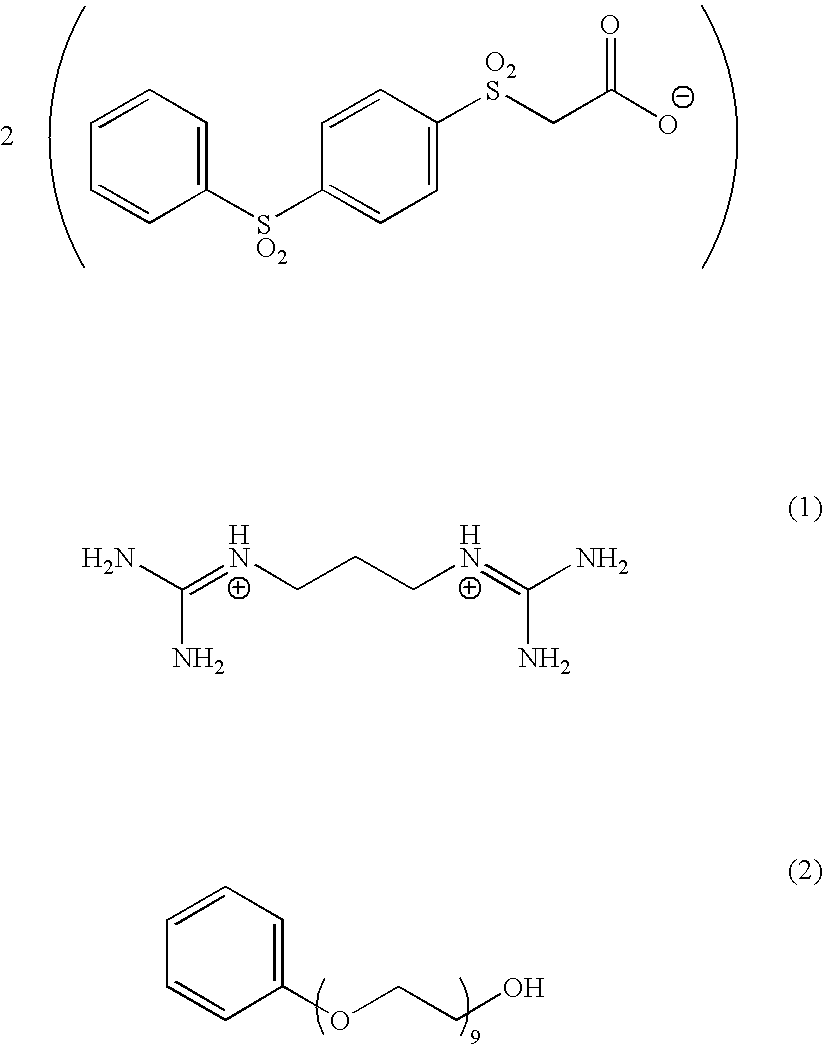Thin-layer metal film
- Summary
- Abstract
- Description
- Claims
- Application Information
AI Technical Summary
Benefits of technology
Problems solved by technology
Method used
Image
Examples
example 1
(Formation of Hydrophilic Surface Containing Metal Salt)
On a PET film (trade name: M4100, manufactured by Toyobo Co., Ltd.) having a film thickness of 0.188 mm, the following photo-polymerizable composition 1 was coated and dried at 80° C. for 2 minutes using a rod bar No. 18. Next, the coated film was preliminarily cured upon irradiation for 10 minutes using a 400-W high pressure mercury vapor lamp (trade name: UVL-400P, manufactured by Riko-Kagaku Sangyo Co., Ltd.), to form an intermediate layer on the substrate.
[Photo-Polymerizable Composition 1]
Allyl methacrylate / methacrylic acid copolymer 4 g (molar ratio: 80 / 20, molecular weight: 100,000): Ethylene oxide-modified bisphenol A diacrylate 4 g (trade name: M210, manufactured by Toagosei Co., Ltd.): 1-Hydroxycylcohexyl phenyl ketone: 1.6 g 1-Methoxy-2-propanol: 16 g
Next, the film having the intermediate layer formed thereon was dipped in an aqueous solution containing acrylic acid (10 wt %) and sodium periodate (NaIO4, 0...
example 2
(Formation of Hydrophilic Surface Containing Metal Salt)
A porous polytetrafluoroethylene film (trade name: FINE POLYMER, WP-500-100, manufactured by Sumitomo Electric Industries, Ltd.) having a film thickness of 0.1 mm was subjected to oxygen glow processing using a plane magnetron sputtering system (trade name: CFS-10-EP70, manufactured by Shibaura Eletec Corporation) under the following conditions. Initial vacuum: 1.2×10−3 Pa Oxygen pressure: 0.9 Pa RF glow: 1.5 kW, Processing time: 60 sec
Next, the glow-processed film was dipped in an acrylic acid aqueous solution (10 wt %) having nitrogen bubbled therein at 70° C. for 7 hours. The dipped film was rinsed with water for 8 hours, to obtain a substrate 2 having a hydrophilic surface on which acrylic acid had been grafted.
(Formation of Metal Film)
The obtained substrate 2 (10 cm×10 cm) was dipped in an aqueous solution of 15% by weight of palladium dichloride (manufactured by Aldrich Corporation) for 12 hours and then rinse...
example 3
(Formation of Metal Film)
The substrate 1 (10 cm×10 cm) as obtained in Example 1 was dipped in an aqueous solution of 15% by weight of cobalt sulfate for 12 hours and then rinsed with distilled water. Thereafter, the substrate was dipped in 100 mL of distilled water and reduced by dropwise addition of 30 mL of 0.2 M sodium hypophosphite. There was thus obtained a uniform thin-layer Co metal film 3 (film thickness: 0.5 μm).
PUM
| Property | Measurement | Unit |
|---|---|---|
| Structure | aaaaa | aaaaa |
| Molecular weight | aaaaa | aaaaa |
| Hydrophilicity | aaaaa | aaaaa |
Abstract
Description
Claims
Application Information
 Login to View More
Login to View More - R&D
- Intellectual Property
- Life Sciences
- Materials
- Tech Scout
- Unparalleled Data Quality
- Higher Quality Content
- 60% Fewer Hallucinations
Browse by: Latest US Patents, China's latest patents, Technical Efficacy Thesaurus, Application Domain, Technology Topic, Popular Technical Reports.
© 2025 PatSnap. All rights reserved.Legal|Privacy policy|Modern Slavery Act Transparency Statement|Sitemap|About US| Contact US: help@patsnap.com

